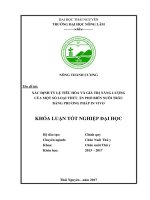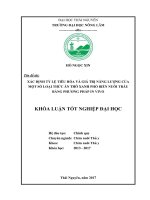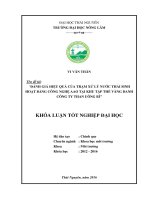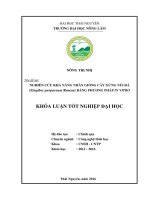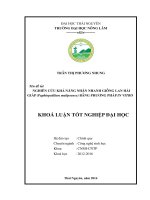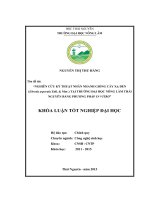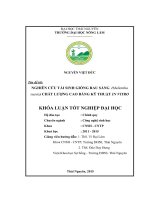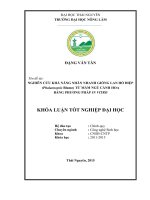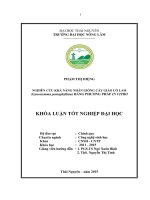Complete the multiplication process of paulownia fortunei in vitro (khóa luận tốt nghiệp)
Bạn đang xem bản rút gọn của tài liệu. Xem và tải ngay bản đầy đủ của tài liệu tại đây (2.6 MB, 49 trang )
VIETNAM NATIONAL UNIVERSITY OF AGRICULTURE
FACULTY OF BIOTECHNOLOGY
-------------***-------------
GRADUATION THESIS
“COMPLETE THE MULTIPLICATION PROCESS OF
PAULOWNIA FORTUNEI IN VITRO”
HANOI, 3/2021
VIETNAM NATIONAL UNIVERSITY OF AGRICULTURE
FACULTY OF BIOTECHNOLOGY
-------------***-------------
GRADUATION THESIS
“COMPLETE THE MULTIPLICATION PROCESS OF
PAULOWNIA FORTUNEI IN VITRO”
Student’s name
: Vu Duc Canh
Class
: K61CNSHE
Faculty
: Biotechnology
Supervisor
: Dr. Nguyen Thi Lam Hai
HANOI, 03/2021
STATEMENT OF ORIGINAL AUTHORSHIP
The work contained in this thesis has not been previously submitted to meet
requirements for an award at this or any other education institution. To the best of my
knowledge and belief, the thesis contains no material previously published or written by
another person except where due reference is made.
Hanoi, February 23rd, 2021
Student
Vu Duc Canh
i
ACKNOWLEDGEMENTS
To complete this graduation thesis, I would like to thank Nguyen Thi Lam Hai.Dr,
and the teachers in the Department of Plant – Faculty of Biotechnology, who have always
been helpful and guided me throughout the process of implementing the topic.
I would like to express my sincere thanks to all of the students working in the
Department of Plant – Faculty of Biotechnology for creating the best conditions to help
me during the time of the thesis.
I would like to express my sincere thanks to the teachers of the Department of
Biotechnology, Vietnam National University of Agriculture for imparting new knowledge
to me, and having a passion for scientific research during my time studying at the
university.
Finally, I sincerely extend my gratitude to my family and friends who have always
supported and encouraged me during my studies and scientific research.
Hanoi, February 23rd, 2021
Student
Vu Duc Canh
ii
CONTENTS
STATEMENT OF ORIGINAL AUTHORSHIP ................................................................. i
ACKNOWLEDGEMENTS ................................................................................................ ii
Content of table ................................................................................................................... v
Content of figure ................................................................................................................. vi
LIST OF ABBREVIATIONS ........................................................................................... vii
ABSTRACT ..................................................................................................................... viii
PART I. INTRODUCTION ................................................................................................ 1
1.1. Preface ....................................................................................................................... 1
1.2. Objectives .................................................................................................................. 2
1.3. Requirements............................................................................................................. 2
PART II. LITERATURE REVIEW .................................................................................... 3
2.1. General introduction.................................................................................................. 3
2.1.1. The origin of the research object ........................................................................ 3
2.1.2. Distribution ......................................................................................................... 3
2.1.3. Scientific classification ....................................................................................... 3
2.1.4. Botanical characteristics of Paulownia fortune .................................................. 5
2.1.5. Advantages and application ................................................................................ 8
2.1.6. Requires external scene .................................................................................... 10
2.2. Reacher Paulownia fortunei trees in the world and in Vietnam ............................. 11
2.1.1.
Research overview in the world .................................................................... 11
2.2.2. Overview of domestic research ........................................................................ 12
PART 3: MATERIALS AND RESEARCH METHODS ................................................ 14
iii
3.1.
Object, material, location, time of culture ........................................................... 14
3.1.1.
Research materials ........................................................................................ 14
3.1.2.
Location, time of culture ............................................................................... 14
3.2.
Content and reseach methods............................................................................... 14
3.3.
Tracking indicators .............................................................................................. 18
PART 4: CONCLUSION AND RECOMMENDATION ................................................. 21
4.1. Conclusion............................................................................................................... 21
4.1.1. Effects of BA and Kinetin on shoot multiplication. ......................................... 21
4.1.2. Effects of BA and IAA on shoot multiplication. .............................................. 23
4.1.3. Effects of BA and IBA on shoot multiplication. .............................................. 25
4.1.4. Effects of coconut milk on shoot multiplication. ............................................. 27
4.1.5. Effects of iron content in MS on shoot photosynthesis, thereby affecting the
shoot multiplication. ................................................................................................... 29
4.1.6. Effects of Vitamin content in MS on shoot metabolism and shoot
multiplication. ............................................................................................................. 31
4.1.7. Effects of Vitamin B2 on growth and development of cultured shoots. .......... 33
4.1.8. Effect of the MS concentration to the rooting (non-sterile - free sugar and liquid
medium). ..................................................................................................................... 35
4.1.9. Effect of α-NAA on rooting (non-sterile and liquid medium). ........................ 36
4.2. Recommendation..................................................................................................... 36
REFERENCES .................................................................................................................. 37
iv
CONTENT OF TABLE
Table 1: The statistic result of effects of BA and Kinetin on shoot multiplication........... 21
Table 2: The statistic result of effects of BA and IAA on shoot multiplication. .............. 23
Table 3: The statistic result of effects of BA and IBA on shoot multiplication. ............... 25
Table 4: The statistic result of Effects of coconut milk on shoot multiplication. ............. 27
Table 5: The statistic result of effects of iron content in MS on shoot photosynthesis,
thereby affecting the shoot multiplication. ...................................................... 29
Table 6: The statistic result of effects of Vitamin content in MS on shoot metabolism and
shoot multiplication.......................................................................................... 31
Table 7: The statistic result of effects of Vitamin B2 on growth and development of
cultured shoots. ................................................................................................ 33
Table 8: The statistic result of effect of the MS concentration to the rooting (non-sterile free sugar and liquid medium). ........................................................................ 35
v
Content of figure
Figure 1. Paulownia fortune shoot....................................................................................... 5
Figure 2. Paulownia fortune leaves ..................................................................................... 6
Figure 3. The inflorescence of Paulownia fortune .............................................................. 6
Figure 4. Fruit of Paulownia fortune .................................................................................. 7
Figure 5. Root system of Paulownia fortune ....................................................................... 7
Figure 6: Effects of BA and Kinetin on shoot multiplication (after 4 weeks) .................. 23
Figure 7: Effects of BA and IAA on shoot multiplication (after 4 weeks) ....................... 24
Figure 8: Effects of BA and IBA on shoot multiplication (after 4 weeks) ....................... 26
Figure 9: Effects of coconut milk on shoot multiplication (after 4 weeks) ....................... 28
Figure 10: Effects of iron content in MS on shoot photosynthesis, thereby affecting the
shoot multiplication. (after 4 weeks) ............................................................... 30
Figure 11: Effects of Vitamin content in MS on shoot metabolism and shoot
multiplication. (after 4 weeks) ......................................................................... 32
Figure 12: Effects of Vitamin B2 on growth and development of cultured shoots. (after 4
weeks) .............................................................................................................. 34
Figure 13: Effect of the MS concentration to the rooting (non-sterile - free sugar and
liquid medium). (after 4 weeks) ....................................................................... 36
vi
LIST OF ABBREVIATIONS
Abbreviations
Annotate
MS
Murashige and Skoog medium
CT
Formula
CV
Coefficient of variation
LSD5%
Least significant differences
BA
Benzylidenes
IAA
Indole-3-acetic acid
IBA
Indole-3-butyric acid
NAA
1-naphthaleneacetic acid
vii
ABSTRACT
Paulownia fortunei is a tree that has a lot of economic value and has high growth
rate, good wood quality, and less pest and disease. The project was conducted to find the
best formula for multiplication in vitro paulownia fortunei and the best rooting recipe
with low economic cost. With the use of disease-free samples and in vitro culture, transfer
to different culture media obtained the following results: the highest shoot multiplier was
obtained on MS medium supplemented with 0.5 mg / L BAP (2.31 cm / plant and 2.14
shoots /plant) tall, fat, strong shoots. With the MS formula supplemented with 0.5 mg / L
BAP and coconut milk, the multiplier was low, however green plants, and healthier and
fresher roots were suitable for complete tree formation. With the formula of iron
supplementation by changing the amount of iron in the MS ingredient by 1.5 times, the
multiplier ratio of 2.53 shoots / plant and the average height of 1.98 cm / plant is obtained,
the plants are greener and healthier. With the formula of changing the amount of Vitamins
by increasing their content in MS and Vitamin B2 supplementing formula, the shoot
multiplication efficiency is not increased, the multiplier factor is not high. culture plants
from culture different medium to non-sterile liquid root medium, medium containing 1/3
of the non-sterile liquid MS is best. The best substrate for planting plants in the garden is
peat moss.
viii
PART I. INTRODUCTION
1.1. Preface
Paulownia fortunei is one of 9 species of tree species in the genus Paulownia
Paulownia fortunei commonly called the dragontree, dragon tree or Fortune's empress
tree, is a deciduous tree in the family Paulowniaceae, native to southeastern China
(including Taiwan), Laos and Vietnam. It is an extremely fast-growing tree, due to its use
of C4 carbon fixation, and is planted for timber harvesting. Paulownia fortunei grow
rapidly, after 6 years, they can be harvested. The wood is very light and hard, resistant to
termites, does not deform when the weather changes, so it is often used as interior
decoration, interior parts of aircraft, yachts, handicrafts, and musical instrument. The
easy-to-dissolve Paulownia fortunei leaves have good soil improvement effects. In
addition, the Paulownia fortunei leaves have a high protein content to make animal feed
effectively. The flowers of this species are beautiful, fragrant, and are used to grow
honeybees, or to prepare some medicines such as asthma (Pham Hoang Ho). In addition,
Paulownia fortunei root is distributed 30-40cm deep below the ground, so it is less
competitive with short-term plants, and it also holds good soil and high economic value,
so it is very suitable for afforestation (Nguyen Nhan Hoai et al, 1999). Due to many
preeminent properties, Paulownia fortunei has been paid attention to research and
development in many countries. 1.8 million hectares of species of the genus Paulownia
have been planted in China. Some other countries such as the US, Canada, and Australia
also pay attention to research and develop this plant. In Vietnam, Paulownia fortunei tree
has been planted in recent years. Trees grow quite quickly in the first few years and show
a wide development potential for the purpose of planting raw material forests, creating
environmental landscape. Paulownia fortunei is also a perennial tree, so it is also used for
planting protective forests. In the nature, it is often intercropped with some pioneer
species, it is easy to intercrop with some other plants such as bamboo, intercropped to
shade agricultural crops or coffee, tea etc.
In vitro propagation of Paulownia fortunei have been and is being researched by
1
scientists in many places. In Vietnam, there are also in vitro propagation projects of
this plant. However, these works are heavy on basic research and the multiplication
coefficient is not high. Stemming from the fact, with a density of planting about 800
trees / ha, with an area of up to hundreds of thousands of hectares, it is very important
to take initiative in the source of Paulownia fortunei seedlings with the need of
millions of trees at the same time. necessary. Therefore, in order to meet the
requirements of the production of high-quality Paulownia fortunei in vitro with good
multiplier, I conducted a research project: "Complete the multiplication process of
Paulownia fortunei in vitro".
1.2. Objectives
The project aims to research and build a process to improve the Paulownia fortunei
variety using in vitro culture technology as the basis and easy to apply in the production
of the Paulownia fortunei variety in large quantities, uniformity, good growth, suitable for
the afforestation in Vietnam.
1.3. Requirements
- Study on the effects of growth regulators on shoot multiplier.
- Study the effect of organic compounds on shoot multiplier.
- Effects of Vitamins, iron on growth and development in Paulownia fortunei in
vitro culture.
- Optimized in vitro root formation of cultured (non-sterile) Paulownia fortunei
shoots.
- Determine the suitable substrate to crown Paulownia fortunei in vitro.
2
PART II. LITERATURE REVIEW
2.1. General introduction
2.1.1. The origin of the research object
The Scrophulariaceae Paulownia is native to Asia. In China, it has been known for
over 2,000 years, while Japan and north Korea have appeared about 1000 years ago. In
the 19th century, the Paulownia was found in some countries in Europe, South America
and Australia. In New Zealand, China Paulownia has been very successful in using for
reforestation. China's Paulownia acreage so far has grown to more than 5 million hectares.
In Vietnam, Paulownia fortunei is one of 9 tree species of the genus Paulownia
which was from the 2000s.
2.1.2. Distribution
Due to many good properties, Paulownia fortunei has been noticed in research and
development in many countries. Paulownia fortunei is distributed naturally in many Asian
countries such as China, Laos, Cambodia, ... In China, there are about 1.8 hectares of
species belonging to the genus Paulownia, some other countries such as the US, Australia
also pay attention to research. development of this plant. In Vietnam, Paulownia fortunei
is grown in some provinces in the North, Central Highlands, some southwestern provinces
with great potential for planting this plant such as An Giang, Hau Giang, Tra Vinh, Soc
Trang ...
2.1.3. Scientific classification
Kingdom:
Plantae
Tracheophytes
Angiosperms
Eudicots
Asterids
Order:
Lamiales
3
Family:
Paulowniaceae
Genus:
Paulownia
Species:
P. fortunei
Binomial name:
Paulownia fortune (Seem.) Hemsl. 1890s.
Synonyms:
Basionym
Campsis fortunei Seem., J. Bot. 5: 373. 1867.
Heterotypic
Paulownia duclouxii Dode, Bull. Soc. Dendr. France 162. 1908.
Paulownia longifolia Hand.-Mazz., Symb. Sin. Pt. 7: 832. 1936, in obs.; Hand.-Mazz. in
Beih. Bot. Centralbl. 56: B. 452. 1937.
Paulownia meridionalis Dode, Bull. Soc. Dendr. France 162. 1908.
Paulownia mikado T.Itô, Icon. Pl. Japon. (Itô) 1(3): tt. 9-12. 1911.
Some of the species recognized by Plants of the World Online and The Plant List:
• Paulownia catalpifolia
• Paulownia elongata
• Paulownia fargesii
• Paulownia fortunei (synonyms: P. duclouxii, P. longifolia, P. meridionalis. P.
mikado)
• Paulownia kawakamii (synonyms: P. ehderiana, P. thyrsoidea, P. viscosa)
• Paulownia tomentosa (synonyms: P. coreana, P. glabrata, P. grandifolia, P.
imperialis, P. lilacina, P. recurva, P. tomentosa var. Glabrata, P. tomentosa var.japonica,
P. tomentosa var. lanata, P. tomentosa var. tomentosa, P. tomentosa f. virginea).
4
2.1.4. Botanical characteristics of Paulownia fortune
Shoot
Figure 1. Paulownia fortune shoot
Bark: Thin-plate, light gray, smooth, with slight cracks in adult trees.The diameter
of the trunk: the circumference of a 1.5-2-year-old tree is 8-14 cm, the circumference of a
3-4 year-old tree is 20-24 cm, and the circumference of an adult 18-year-old tree is up to
80 cm. Wood of Paulownia accumulates the substance of tannin, which makes it resistant
to eating by termites and wood fretters. Paulownia feels good in urban conditions.
5
Foliage:
Figure 2. Paulownia fortune leaves
Features of the plant: in the first year of life, the tree has large fibrous leaves,
which can reach 50-85 cm in diameter. The leaves are heart-shaped or ovate with round
edges, bright green, fluffy from above, and tomentose from below. Color is of the autumn
foliage: it does not change. The leaves drop off when they are green, then they turn
brown.
The inflorescence
Figure 3. The inflorescence of Paulownia fortune
The flowering of Paulownia comes at spring and lasts for 6-8 weeks, which makes
the Paulownia tree an ideal material for the greening of cities and park areas. The flowers
6
are large. Their color is bluish-violet, lilac or almost white. The flowers are collected in
large apical panicles.
Fruit
Figure 4. Fruit of Paulownia fortune
Fruits: Long, hooked wood capsules up to 10 mm in size.Seeds: Butterfly-shaped,
2-7 mm long, membranous, winged.
Root system
Figure 5. Root system of Paulownia fortune
Tap-root system (anchor) root system. The root reaches a depth of 4.5-9 m.
7
2.1.5. Advantages and application
Paulownia is a tree adaptable to the terrain, it is weather resistant, it recovers and
regenerates the soil, very decorative and beautiful, environmentally non-aggressive
planting, as well as it is an oxygen manufacture and a weapon against global warming, it
is a producer of cellulose, fodder and excellent nectariferous plant, while Paulownia is
growing rapidly and gaining weight. Paulownia has all properties and qualities that we
can use: might and beauty, wood, leaves, flowers!!!
2.1.5.1. Ultra growth
Growth in the size of 1 cubic meter for 7-8 years is incomparable with the growth
of any other tree species. The plant as a whole, with its accelerated growth, is a small
treasure for humanity: it heals and regenerates soils from erosion, one tree absorbs 22 kg
of CO2 and gives 6 kg of oxygen, only think about these figures!
2.1.5.2. Low maintenance seedlings
Prepared, quality seedlings of the Paulownia tree with a strengthened root system
are able to grow on infertile soils, including clay soils.
2.1.5.3. Landscaping
Huge leaves and a large crown provide a thick, dense shadow in resting places,
parks and squares, forming pleasant cool parts in the center of the gassy and stuffy cities.
If there is a tree about which you can say “urban lungs”, this is Paulownia.
2.1.5.4. Fodder for livestock
Leaves (foliage mass) of Paulownia are often used for fattening of cattle (cows,
sheep, goats, etc.) The qualities of Paulownia are close to the qualities of alfalfa. It
contains about 20% of the proteins in the green state and about 12% after the fall foliage.
It is saturated with microelements; its digestibility is 60%. The highest percentage of
protein content is found in annual plants. Therefore, if the main purpose is to obtain
nutrient biomass from Paulownia for the fattening of cattle, it is advisable to create a
8
separate plantation and harvest a quality crop at the end of the summer period.
Technologies of plantation growing of fast-growing Paulownia trees for production of
plant biomass for 1 year on an area of 1 hectare will allow receiving 35-40 tons of quality
plant raw materials. Availability and high yield provide low prime cost for fattening – one
of the most important indicators when choosing fodder in the industrial livestock
production.
2.1.5.5. Cosmeceuticals
It is established that the leaves of Paulownia contain substances that have
beneficial effects on the liver, kidney and gallbladder, and the leaves of Paulownia are
also used for problems with the lungs. In China, the properties of the leaves of Paulownia
have been known for a long time, even the pharmaceutical industry is involved in the
industrial production of Paulownia-based medicines. Leaves of Paulownia have other
properties: their use in cosmetics in Asian countries is as old as their application in
medicine, but it is a novelty for Europe. Only in recent years, extracts from the leaves of
Paulownia are included in the composition of medicines, creams and perfumes
2.1.5.6. Perfumery
Awakening from winter hibernation in February and March, Paulownia grows
flowers in the form of a bell, each up to 6 cm in diameter, fleecy, bluish violet, lilac or
almost white. The aroma (notes) of flowers of Paulownia is defined as vanilla, powdery
and slightly almond. It is established that this is due to the heliotropin substance contained
in the aroma known in perfumery and present in other flavors (e.g. Tahitian vanilla). The
aroma of flowering Paulownia is analyzed by the so-called “GC mass spec” (Gas
chromatography–mass spectrometry) method, based on gas chromatography and mass
spectrometry.
2.1.5.6. Honey
In addition to beauty, the flowers of Paulownia are also distinguished by strong,
fragrant aroma and they are an excellent nectariferous plant! From one hectare of
9
Paulownia it is possible to receive 800 kg and more honey. The advantage is that when
growing Paulownia tree, the chemical products are not used at all, so we do not harm bees
that do not tolerate the use of herbicides and other chemicals, receiving a NATURAL
(ECOLOGICALLY CLEAN) product. Honey from Paulownia is light, transparent, very
bright and fragrant. Honey farm Paulownia can be compared only with honey from acacia
by its color and consistency. Honey from Paulownia, as well as acacia, is of the highest
quality. In addition to being a delicacy, it also serves as a medicine. Its properties are
known as such that have beneficial effects and help in the treatment of bronchitis, lungs
and respiratory system diseases, and Paulownia also improves the function of the
gallbladder, liver and digestion in general. The qualities of Paulownia honey are
determined by biologically active substances in its flowers, so that flowers themselves are
used for food.
2.1.5.7. Application in food
In addition to the Chinese experience in this respect, we cannot miss the
fashionable use of Paulownia’s flowers in the form of horns with cream – it can sound
like an exotic dessert, but it is already a part of the menu of many European restaurants.
2.1.6. Requires external scene
2.1.6.1. Weather condition
In areas at an altitude of 300-1500m with an average rainfall of 1500-1884mm,
Paulownia fortunei can be planted. Paulownia fortunei is able to grow and develop well
in the region with the average annual temperature from 18-25 0C, the average temperature
of the hottest month from 28-300C, the average temperature of the coldest month 9-130C
and the dry season. 3-4 months long.
2.1.6.2. Planting soil conditions Paulownia fortunei
This is a plant with high adaptability to different growing conditions, but the most
suitable soil for planting is feralit soil on granite, gnai, clay, mica, ... In that, soils with
surface humus greater than 1%, light to medium mechanical composition, layer over 50
10
cm thick, porous soil with good permeability and drainage are also suitable for growing
Paulownia fortunei. Paulownia fortunei is not suitable for growing on areas where the
soil is tight, waterlogged, the soil is too degraded, rock inert.
2.2. Reacher Paulownia fortunei trees in the world and in Vietnam
2.1.1. Research overview in the world
- Radojevic L. (1979) from sexual tissue to create callus and callus tissue culture
then create embryos directly from the callus and develop embryos on MS medium.
- Saito A (1976) isolation of protoplasts from mesophyll cells of Paulownia fortunei
Hemsl.
- Burger D.W (1985) cultured axillary shoots to produce plants on MS / 2 medium.
- In 1986, Zhu and his colleagues said that the Paulownia fortunei was used for
many purposes such as wood stalks, leaves for fertilizer and food for health, flowers for
medicine, ...
- In 1988, Marcotrigiano and Jagnnathan researched that the basil trees in Southeast
Asia, are grown in many parts of the world, and are able to adapt to the wetlands with
unfavorable climates.
- Paulownia fortunei can be grown from seed, root segment or stem segment,
however tissue culture method is considered to be the most effective method for rapid
multiplication of the non-Vietnamese lineage (Rao et al., 1996; Bergmann and Moon,
1997; Kuman et al., 1998).
- Paulownia fortunei cultured in vitro under the photo-autotrophic condition (with
20g / l of sugar and vitamins in MS) grows significantly better than plants grown under
heterotrophic conditions. In the photo-autotrophic conditions, in vitro Paulownia fortunei
grew faster in the condition that the CO2 concentration of the nursery room was increased
to 160mm / ml under 250mm m-1s-2 light intensity (Kozai and Iwanami, 1988; Kozai ,
1991; Kirdmanee, 1995).
- Evaluation of the development of biotechnology methods for plant breeding and
genetic improvement, and the antioxidant potential of secondary metabolites occurring in
11
the Paulownia fortunei (Niraj Kumarmangalam Yada and partners, 2013).
2.2.2. Overview of domestic research
- Dr. Tran Kim Tinh (Can Tho University): Planting Paulownia fortunei with seeds
and tissue transplants in Hau Giang, providing raw materials for paper mills.
- The Institute of Tropical Biology (National Center for Natural Science and
Technology) imported the original seed, propagated by multiplying shoot clusters on MS
medium (1962).
- City Forest Seed Company. HCM propagated by microcutting method on medium
supplemented with low concentration BA.
- Bui Duy Ngoc, Nguyen Dinh Hoi, Nguyen Thi Minh Xuan (2007): Initial research
on improving volume of Paulownia fortunei. Journal of Forestry Science No. 1/2007,
pages 291-296.
- Thai Xuan Du: Effect of nutrient concentration, ventilation and condition of the
culture vessel on the groth of Paulownia fortunei cultured in vitro. (Effects of nutrient
concentration and ventilation condition of the culture vessel on the groth of Paulownia
(Paulownia fortunei) cultured in vitro.) Journal of Scientific Advances (2002).
- Doan Thi Ai Thuyen, Vu Ngoc Phuong, Thai Xuan Du & Nguyen Van Uyen:
Clonal propagation of the Paulownia fortunei (Seem Hemsl). By tissue culture methods.
Journal of Biology 23 (3), 46-50 (2001).
- Vu Ngoc Phuong, Doan Thi Ai Thuyen, Luu Viet Dung, Thai Xuan Du & Nguyen
Van Uyen (2001): The process of nursery tree (Paulownia fortunei) in the post-test
period. In: Biotechnology and Ecological Sustainable Agriculture. Institute of Tropical
Biology. Agricultural Publishing House. 69-75.
- Luu Viet Dung: Clonal propagation of Paulownia fortunei (Seem Hemsl) by tissue
culture method. Journal of Biology, Vol. 24 No. 2 (2002).
- Luu Viet Dung: The process of nursery tree (Paulownia fortunei) tissue culture.
Journal of Biology, Agricultural Publishing House (2001).
- Thai Xuan Du: The process of cultivating Paulownia fortunei in the post-test
12
period. Journal of Biotechnology and Eco-Sustainable Agriculture, Agricultural
Publishing House (2001).
- Le Tan Duc: Creating a transgenic insect resistant plant (Paulownia fortune)
through Agrobacterium Tumefaciens bacteria. National Biotechnology Conference
(2003).
- Le Tan Duc: Research on in vitro regeneration system of Paulownia fortunei and
effects of selective agent to create transgenic plants. National Biotechnology Conference
(2003).
- At the tissue culture laboratory of the forest vine research center, Vietnam Institute
of Forestry Science and Technology, the scientists successfully disintegrated in vitro
culture from seeds and transplanted in the soil environment with billions rate is high
- In the period from 2001 to 2003 when the new Paulownia fortunei seedling was
imported to Vietnam, the research on in vitro propagation of Paulownia fortunei and the
post-test tube stages was also studied in many units in Vietnam. Luu Viet Dung (2002)
also succeeded in clonal propagation of Paulownia fortunei by plant cell tissue culture
method (Journal of Biology, vol. 24, No. 2).
- Thai Xuan Du (2002) studied the effect of nutrient concentration and aeration
conditions of the culture vessel on the growth of Paulownia fortunei plants in vitro, the
study results showed that 1 / 2MS environment is preferred. suitable for the rapid
multiplication of Paulownia fortunei, the aeration condition of the pond has a great
influence on the development of Paulownia fortunei in vitro.
13
PART 3: MATERIALS AND RESEARCH METHODS
3.1. Object, material, location, time of culture
3.1.1. Research materials
In vitro P.fortunei shoots.
3.1.2. Location, time of culture
- Location: Laboratory of Plant Biotechnology - Faculty of Biotechnology, Vietnam
National University of Agriculture.
- Time of culture: Time: September 2020 – March 2021 .
3.1.3. Research tools
- Sterilizer, sterile culture box, triangle flask, pipette, pH calibrator, piston, knife,
scissors, cutter, UV lamp, technical scale, analytical balance, oven, rig system lights,
magnetic stirrers….
- Chemicals: The chemicals used in plant multiplication, MS medium used in
research include macronutrients and micronutrients according to Mura shige and Skoog.
Saccharose, Agar, growth stimulants such as BAP, NAA, Kinetine, IBA ...
- Cultured under temperature conditions 25- 27oC and lighting mode 12h / 12h with
2000lux light intensity.
3.2. Content and reseach methods
Research indicators were divided into different experimental formulas and
control formulas.
Number of samples of each experimental formula was greater than or equal to 30.
The experiment was repeated 2 times.
Content 1: Multiplication
Samples of shoots containing buds approximately 1.5 cm length in vitro
culture media on MS medium which were transferred to media containing different
growth regulators to increase shoot multiplier
14
•
Basic culture medium: MS + 3% succrose + 7 g/l agar + 0.5mg/l BA
Experiment 1: Effects of BA and Kinetin on shoot multiplication.
Formula
Kinetin (mg/l)
1
F1
0.0
2
F2
0.5
3
F3
1.0
4
F4
1.5
5
F5
2
Experiment 2: Effects of BA and IBA on shoot multiplication.
Formula
IBA (mg/l)
1
F1
0.0
2
F2
0.1
3
F3
0.2
4
F4
0.3
5
F5
0.4
Experiment 3: Effects of BA and IAA on shoot multiplication.
Formula
IAA (mg/l)
1
F1
0.0
2
F2
0.1
3
F3
0.2
4
F4
0.3
5
F5
0.4
15

